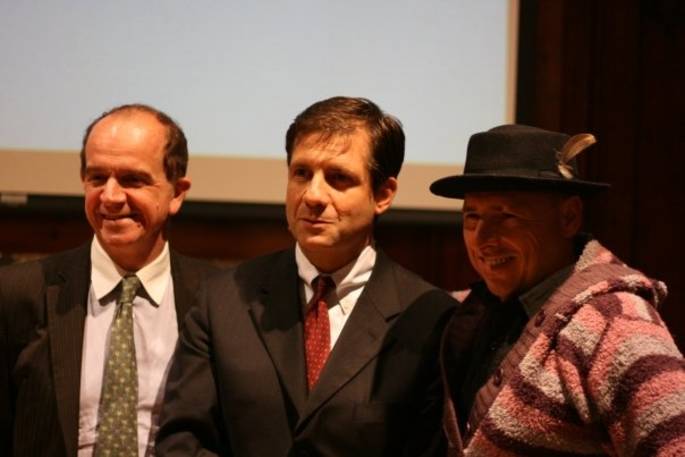


The scene at the Italian Cultural Institute last week was striking for a few reasons. In addition to the local cast of characters that participate in events at the Institute, many new faces were in attendance in order to watch the New York premium of Focaccia Blues.
Pat Girondi, a consultant to the film and financial backer, was on hand to discuss the idea for the film. “We were looking at the hill of the city and saw the McDonald’s. It was very incongruous and just a scandal. We began talking about what we could do about it,” Girondi said. A real character, Girondi grew up on the South Side of Chicago in what he said was a very tough neighbor. Girondi eventually left the South Side and went on to become a successful businessman. Girondi’s grandparents came from Apulia and listening to the mixed Chicago/Italian accent from that region was quite fascinating.
Girondi and his family eventually moved back to Apulia in order to care for his son who has Thalassemia, a disease which affects certain populations, among
them people of Italian descent. Girondi began working hard to find a cure for the disease, creating the Orphan Dream Foundation and partnering with others who work on this incurable disease.
Girondi’s new career as a film producer and song writer keep him busy as he works to raise money to cure his son’s disease. Clinical trials for a potential drug are in the final stages.
Focaccia Blues is a docu-fiction according to Italian actor Lino Banfi who together with Renzo Arbore, another beloved Italian actor does a little skit about the rivalry between two cities in Apulia, Bari and Foggia. Even for those who have never been to Apulia, this film will give you a sense of a place and of its people and will lure you into taking your next trip to Apulia. While the film was playing, fabulous aromas of focaccia permeated the entire room. Luckily the institute offered focaccia to the hungry crowd at the end of the film. If they hadn’t, it is possible there may have been a mutiny or at the very least, a run on the nearest place where it is sold. The film is essentially the story of how one little focaccia shop was able to contribute to the disappearance of McDonalds, the interloper. McDonalds in the movie is cleverly represented by a tall actor in a red jacket, driving around pompously in a yellow corvette while continuously blocking traffic.
The golden arches are seen as well as they cover up poor Dante the protagonist’s tomatoes which are drying in the sun. Mr. McDonald’s most egregious act though is not succumbing to the charms of Rosa, the female protagonist and her home made focaccia. He takes a slice, sneers at it and begins to take off the layers of crushed home grown tomatoes, true sacrilege.
One of the main themes running throughout the film is the superfluous nature of a McDonald’s in a town like Altamura. The director interviews numerous people in town to find out their ideas and if they had visited McDonald’s or not. What develops is truly comic as each of the town’s members become familiar faces.
What we learn is that people went and tried McDonald’s because it was new but then went back to their old ways and their traditions. After all, Altamura is the city of bread, the first (Il tuo browser potrebbe non supportare la visualizzazione di questa immagine)denominazione origine protettta (DOP) bread product in Europe. Some older members of the population went into McDonald’s for the air conditioning, bringing along a slice of focaccia.
Intertwined with the story of the focaccia shop is a love story between Dante, the fruit seller and Rosa, a sexy local lady with impossibly plunging necklines. Dante’s quest for his lady love passes through a series of products and herbs that he gives her, hoping to entice her into a more meaningful relationship. Our hero is thwarted for a time but Rosa eventually comes to her senses.
The film is a labor of love about maintaining traditions. It is also very funny. The audience burst out into giggles a variety of times. Lino Banfi and Renzo Arbore do a wonderful skit wearing human form aprons that you can buy on the street in Italy .
The documentary part of the movie is Onofrio Pepe’s travels to the U.S. to ask people questions and to visit the McDonald museum. Obviously the countryside in Apulia compares favorably with the skyscrapers and grim cityscapes of cities in the United States.
However, this film is not anti-American in any way. Nor even anti-McDonald’s. It’s just a love story about people who care deeply about the place where they were raised and would like to see the traditions of old continue. If you go to see it, make sure you bring something to eat.
Source URL: http://test.casaitaliananyu.org/magazine/focus/life-people/article/focaccia-blues-promotes-italian-foods-while-benefitting-orphan
Links
[1] http://test.casaitaliananyu.org/files/051244682559jpg
[2] http://www.focacciablues.it
[3] http://www.orphansdreamfoundation.com/